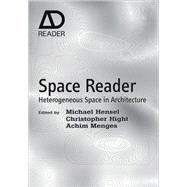
Note: Supplemental materials are not guaranteed with Rental or Used book purchases.
Purchase Benefits
Looking to rent a book? Rent Space Reader Heterogeneous Space in Architecture [ISBN: 9780470519424] for the semester, quarter, and short term or search our site for other textbooks by Hensel, Michael; Menges, Achim; Hight, Christopher. Renting a textbook can save you up to 90% from the cost of buying.
Dipl Ing Grad Dipl Des AA Architekt AKNW
Member OCEAN Research Network
Professor for Research by Design, AHO Oslo School of Architecture and Design
Director, Emergent Technologies and Design, Architectural Association School of Architecture, London
Innovation Fellow – UTS University of Technology Sydney
Board Member BIONIS (Biomimetics Network for Industrial Sustainability)
Michael U Hensel is an architect, researcher and writer. He is a member of the independent and
interdisciplinary research network OCEAN and a board member of BIONIS (the Biomimetics
Network for Industrial Sustainability). His writings and collaborative research and design work have
been published worldwide. He has lectured and taught worldwide and is currently Professor for
Research by Design at AHO, the Oslo School of Architecture and Design and Director of the
Emergent Technologies and Design masters programme at the Architectural Association in London.
Recent publications he co-edited include: AD Emergence: Morphogenetic Design Strategies (John
Wiley & Sons Limited, 2004); AD Techniques and Technologies in Morphogenetic Design (John Wiley
& Sons Limited, 2006); Morpho-Ecologies (AA Publications, 2006); AD Versatility and Vicissitude:
Performance in Morpho-Ecological Design (John Wiley & Sons Limited, 2008); Arch+ Vol. 188 Form
Follows Performance – Zur Wechselwirkung von Material, Struktur, Umwelt (Archplus Verlag, 2008).
He is currently working on a peer-reviewed journal on research by design and is an editorial board
member of AD (John Wiley & Sons Limited) and JBE (Journal of Bionic Engineering, Elsevier Scientific
Press).
www.ocean-designresearch.net
Christopher Hight
BA, BArch, MA, PhD
Assistant Professor, Rice School of Architecture, Rice University
Christopher Hight is an assistant professor at the Rice School of Architecture where he is pursuing
design research on the nexus of landscape, ecology and emerging forms of urbanisation. He has
been a Fulbright Scholar and obtained a masters degree in histories and theories of architecture
from the Architectural Association (AA), and a PhD from the London Consortium at the University of
London. He has taught in the Architectural Association’s Design Research Laboratory (DRL) and has
worked for the Renzo Piano Building Workshop. He was the co-editor of AD Collective Intelligence in
Design (John Wiley & Sons Limited, 2006) and has recently published a book on cybernetics, posthumanism,
formalism and post-World War II architectural design, Architectural Principles in the Age of Cybernetics (Routledge, 2008).
Achim Menges
AA Dipl (Hons) RIBA II
Professor for Computational Design
Director of the Institute for Computational Design, Faculty of Architecture, Stuttgart University
Studio Master Emergent Technologies and Design, Architectural Association School of Architecture,
London
Member OCEAN Research Network
Partner Emergence and Design Group
Achim Menges is Director of the Institute for Computational Design at Stuttgart University. He has
been teaching at the Architectural Association as Studio Master of the Emergent Technologies and
Design masters programme since 2002 and as Unit Master of Diploma Unit 4 from 2003 to 2006.
From 2005 to 2008 he was Professor for Form Generation and Materialisation at the HfG Offenbach
University for Art and Design in Germany.
Achim Menges’s research focuses on the development of integral design processes at the
intersection of evolutionary computation, parametric design, biomimetic engineering and computeraided
manufacturing that enable a highly articulated, performative built environment. His research
projects have been published and exhibited in Europe, Asia and the United States. He received the
FEIDAD (Far Eastern International Digital Architectural Design) Outstanding Design Award in 2002,
the FEIDAD Design Merit Award in 2003, the Archiprix International Award 2003, RIBA Tutor Price
2004, the International Bentley Educator of the Year Award 2005 and the ACADIA 2007 Award for
Emerging Digital Practice.
Recent publications he has co-edited include: AD Emergence: Morphogenetic Design Strategies (John
Wiley & Sons Ltd, 2004); AD Techniques and Technologies in Morphogenetic Design (John Wiley &
Sons Ltd, 2006); Morpho-Ecologies (AA Publications, 2006); AD Versatility and Vicissitude:
Performance in Morpho-Ecological Design (John Wiley & Sons Ltd, 2008); Arch+ Vol. 188 Form
Follows Performance – Zur Wechselwirkung von Material, Struktur, Umwelt (Archplus Verlag, 2008).
| Foreword | p. 7 |
| En route: Towards a Discourse on Heterogeneous Space beyond Modernist Space-Time and Post-Modernist Social Geography | p. 9 |
| Questions of Space | p. 39 |
| The Smooth and the Striated - The Mathematical Model | p. 44 |
| Mass Absence | p. 52 |
| Figures, Doors and Passages | p. 73 |
| Towards A New Architecture | p. 97 |
| From Object to Field: Field Conditions in Architecture and Urbanism | p. 118 |
| An Introduction to Umwelt | p. 145 |
| Environmental Management | p. 149 |
| Putting Out the Fire with Gasoline Parables of Entropy and Homeostasis from the Second Machine Age to the Information Age | p. 159 |
| Atmospheric Politics | p. 173 |
| The Inside of Space: Some Issues Concerning Heterogeneity, the Interior and the Weather | p. 185 |
| The Heterogeneous Space of Morpho-Ecologies | p. 195 |
| Biographies | p. 216 |
| Select Bibliography | p. 218 |
| Index | p. 220 |
| Table of Contents provided by Ingram. All Rights Reserved. |
The New copy of this book will include any supplemental materials advertised. Please check the title of the book to determine if it should include any access cards, study guides, lab manuals, CDs, etc.
The Used, Rental and eBook copies of this book are not guaranteed to include any supplemental materials. Typically, only the book itself is included. This is true even if the title states it includes any access cards, study guides, lab manuals, CDs, etc.